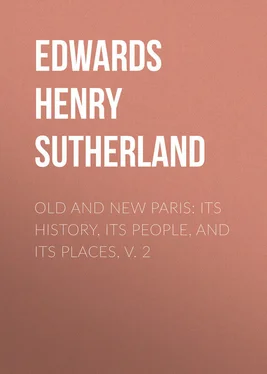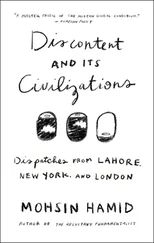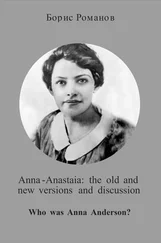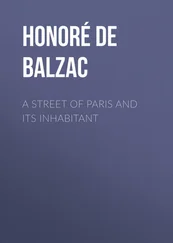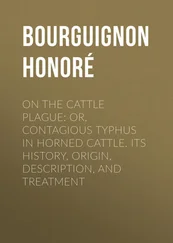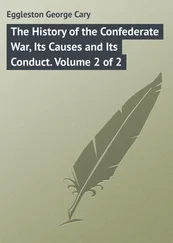Henry Edwards - Old and New Paris - Its History, Its People, and Its Places, v. 2
Здесь есть возможность читать онлайн «Henry Edwards - Old and New Paris - Its History, Its People, and Its Places, v. 2» — ознакомительный отрывок электронной книги совершенно бесплатно, а после прочтения отрывка купить полную версию. В некоторых случаях можно слушать аудио, скачать через торрент в формате fb2 и присутствует краткое содержание. Жанр: foreign_antique, foreign_prose, Путешествия и география, на английском языке. Описание произведения, (предисловие) а так же отзывы посетителей доступны на портале библиотеки ЛибКат.
- Название:Old and New Paris: Its History, Its People, and Its Places, v. 2
- Автор:
- Жанр:
- Год:неизвестен
- ISBN:нет данных
- Рейтинг книги:4 / 5. Голосов: 1
-
Избранное:Добавить в избранное
- Отзывы:
-
Ваша оценка:
- 80
- 1
- 2
- 3
- 4
- 5
Old and New Paris: Its History, Its People, and Its Places, v. 2: краткое содержание, описание и аннотация
Предлагаем к чтению аннотацию, описание, краткое содержание или предисловие (зависит от того, что написал сам автор книги «Old and New Paris: Its History, Its People, and Its Places, v. 2»). Если вы не нашли необходимую информацию о книге — напишите в комментариях, мы постараемся отыскать её.
Old and New Paris: Its History, Its People, and Its Places, v. 2 — читать онлайн ознакомительный отрывок
Ниже представлен текст книги, разбитый по страницам. Система сохранения места последней прочитанной страницы, позволяет с удобством читать онлайн бесплатно книгу «Old and New Paris: Its History, Its People, and Its Places, v. 2», без необходимости каждый раз заново искать на чём Вы остановились. Поставьте закладку, и сможете в любой момент перейти на страницу, на которой закончили чтение.
Интервал:
Закладка:
The coat of mail was not abandoned, but it was worn shorter and of lighter make, without its former accessories, and thus greater lightness and greater facilities of movement were gained.
The warrior towards the end of the thirteenth century was oppressed by his equipment, and did not get off his horse. After the transformation he was able to fight on foot, as he did in all the celebrated battles of the fourteenth century, beginning from Crécy (1346).
After the adoption of steel armour the coat of mail was still for a time worn underneath; but as the steel armour became more solid the coat of mail was gradually abandoned. The museum contains the complete armour of a man and horse, which dates from the middle of the fifteenth century.
Towards the end of that century the armour of the man of war had reached perfection. Every kind of shield had now been given up as useless; plate armour furnished every necessary defence, for it was only when the armour was weak that any additional protection was necessary. Thus the Norman coat of mail, as worn by William’s invading army, presented in its species of trellis-work enormous gaps, and for his complete defence the horseman protected himself with a long shield in the form of a heart, which in action covered the whole of his left side – the side he presented to the foe. As the armour becomes more effective the necessity for a shield diminishes, and, after getting smaller and smaller, it at last disappears. The Artillery Museum contains a suit of armour by Turenne, which shows what plate armour had become at the end of the seventeenth century. It was abandoned altogether at the beginning of Louis XIV.’s reign; the last helmets worn in France and England belonging to the time when this head-gear formed part of the armour of Cromwell’s Ironsides.
Among the innumerable specimens of arms preserved in the Museum of Artillery, portable arms are classed apart from those which strike at a distance, the latter including spears, javelins, bows and arrows, cannon, and every kind of fire-arm. The bow was the arm of the English, the crossbow that of the French. With the former the archer could fire more quickly, and it was easier to preserve the string from getting wet; of which the advantage was experienced on the English side during the battle of Crécy.
The English retained the use of the bow long after the French had abandoned that of the crossbow; and, according to the director of the Musée d’Artillerie, English bowmen were seen in action as late as 1627, at the siege of Rochelle. Companies of archers disappeared from the French army under Louis XII., about the year 1514. The last time, however, that bows and arrows were seen in European warfare was at the battles of Eylau and Friedland, in 1806, when, according to M. Thiers (“History of the Consulate and Empire”), some of the Tartar troops in the Russian army appeared armed with these antique, and for the most part obsolete, engines of war.
Musketry of every kind is represented in the Museum of Artillery, from the earliest to the latest patterns, including, in particular, the flint locks used in the wars of the Empire, percussion locks, by which they were replaced, the rifles adopted just before the Crimean war, and the quick-firing muskets of the most recent models, including the chassepot, associated with the war of 1870 and 1871, and the “fusil Gras,” which replaced it. The word artillery was formerly applied to every implement of war, though since the introduction of musketry it has been used only to designate guns of large calibre drawn by horses, as distinguished from portable fire-arms. Nevertheless, the first specimens of artillery, in something like the modern sense of the word, were of small bore, and the projectiles were the balls used in connection with the crossbow. The French employed artillery of this kind as far back as the battle of Crécy (1346). Gradually the bolts of the crossbow were replaced, for artillery fire, by leaden balls, called plummets (“plommées”), of about three pounds’ weight; these were used in cannons of modern shape, and by degrees the size of the balls was increased until soon the artillery of an army was divided into light and heavy.
The discoveries of the monk Berthold Schwartz belong to the middle of the fourteenth century; and though this learned, but not perhaps beneficent, inventor revolutionised the art of war, he cannot be accused, in pursuing his studies, of having had any deadly purpose in view.
The earliest fire-arms were loaded at the breech by means of a box which was received in a strong stirrup and fastened with a key; and with the use of breech-loading pieces the history of artillery begins, and up to the present time ends. Soon after the introduction of artillery a rapid augmentation took place in the size of the guns employed, and cannon-balls of stone were used. These were replaced by smaller balls made of cast iron, but even to the present day the weight-carrying power of a gun is estimated on the supposition that the ball is of stone. Stone cannon-balls were used by the Turks long after they had been abandoned in European armies; so also were pieces of immense calibre. In Western Europe cast-iron balls were found to be more effective than the larger balls of stone.
The Artillery Museum contains specimens of every kind of cannon used, from the original breech-loader to the breech-loader of the present day. No. 1 of the catalogue is a small cannon of the earliest period, made of forged iron and furnished with a breech-loading apparatus; 14 and the numbers following are siege-pieces of various kinds abandoned by the English at Meaux, after the bombardment of 1422. The projectiles for these pieces were of stone. No. 7 comes from the ancient residence, near Verdun, of the Knights of Malta; and next to it is a fine cannon in bronze given to the Knights of Rhodes by the Emperor Sigismund in 1434. No. 19, also in bronze, belongs to the reign of Louis XI.; and, like No. 18, comes from Rhodes. It bears this inscription: – “At the command of Loys [Louis], by the grace of God King of France, eleventh of this name, I was cast at Chartres by Jean Chollet, knight, artillery master to this sovereign.” Next but one in the series is a large mortar of bronze, cast at the command of the Grand Master of the Order of the Hospitallers of Jerusalem, Pierre d’Aubusson, 1480.
The construction of the various pieces, as we follow them in chronological order, becomes simplified, then complicated, then simplified again. Gun-carriages and ammunition-chests vary in form, until we find at last the field artillery, under Napoleon III., of one pattern; though two kinds of guns, light and heavy, are still used in the reserve artillery. The rifled cannon introduced by the Emperor Napoleon, which did such effective service during the Italian war of 1859, was looked upon by the French as the best possible field-gun; and, possibly from exaggerated loyalty taking the form of servility, the commission of officers to whom the breech loading rifled guns of Krupp were submitted a few years before the war of 1870 rejected them as in no way superior to the gun of Napoleonic invention actually in use. Since the last war the French have adopted breech-loading rifled pieces more or less on the model of the Krupp guns, treated with such disdain by the military advisers of Napoleon III.
Next to the pieces arranged in chronological order have been placed a number of foreign guns taken at various epochs from the enemy, including, among the latest acquisitions of this kind, a number of curious highly ornamented Chinese guns. Apart from the interesting exhibition of musketry and artillery in the military museum, a few words may here be said on the history of fire-arms generally. The use of fire-arms preceded by some centuries the famous invention of the German monk, Berthold Schwartz; which, in Europe, is known to have been anticipated a century earlier by the English monk, Roger Bacon. The art of making gunpowder was known in the second half of the thirteenth century to the Arabs of the north of Africa and the Moors of Spain.
Читать дальшеИнтервал:
Закладка:
Похожие книги на «Old and New Paris: Its History, Its People, and Its Places, v. 2»
Представляем Вашему вниманию похожие книги на «Old and New Paris: Its History, Its People, and Its Places, v. 2» списком для выбора. Мы отобрали схожую по названию и смыслу литературу в надежде предоставить читателям больше вариантов отыскать новые, интересные, ещё непрочитанные произведения.
Обсуждение, отзывы о книге «Old and New Paris: Its History, Its People, and Its Places, v. 2» и просто собственные мнения читателей. Оставьте ваши комментарии, напишите, что Вы думаете о произведении, его смысле или главных героях. Укажите что конкретно понравилось, а что нет, и почему Вы так считаете.
